Supai
Dusk was nearing when we reached the edge of Havasu Canyon – one of the branches of the Grand Canyon. To be more precise, the road simply ended and we saw a giant hole in the ground – an immensely enormous hole!
We were expecting to find a motel in the vicinity, but there was nothing in sight – not even a tiny shop. We only found a parking area where people were slowly getting ready to sleep in their cars. To make things worse, there were no facilities with running water. We were not prepared for that, contrary to the "inhabitants" of the parking area. They filled our water bottles, and tried to talk us out of cycling down the canyon. "The only way you can go down is on foot, or on horseback – with a guide. It is definitely too steep for a bicycle", they explained. The moment they said it, we knew we would take the risk on bikes, which was a case of typically Polish defiance.
We slept in a tent that night. As we found out in the morning, we put it up on a helicopter landing site - an unintended flight of fancy.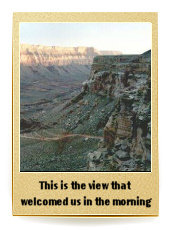
After waking up at 7 am, we quickly took down our tent, packed our backpacks, hopped on the bikes, and off we went. The road downhill was challenging indeed,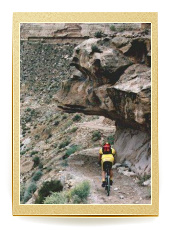
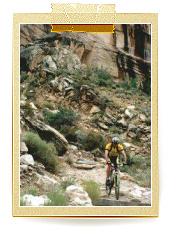 initially very steep, overlooked by canyon walls. Occasionally we had to jump over obstacles, or even get off the bicycles. Further down the canyon the trail became boggy, covered with rubble. Fast cycling was out of the question.
initially very steep, overlooked by canyon walls. Occasionally we had to jump over obstacles, or even get off the bicycles. Further down the canyon the trail became boggy, covered with rubble. Fast cycling was out of the question.
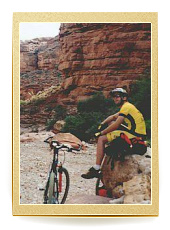 The tourists we passed on our way stared at us with amazement. We also met the people who had advised us against cycling just a night before. In two hours' time we managed to cover a distance of 13 km, reaching the village of Supai, inhabited by the Havasupai Indians exclusively. The village is situated in a valley, separated from the outside world by vertical canyon walls reaching hundreds of meters up.
The tourists we passed on our way stared at us with amazement. We also met the people who had advised us against cycling just a night before. In two hours' time we managed to cover a distance of 13 km, reaching the village of Supai, inhabited by the Havasupai Indians exclusively. The village is situated in a valley, separated from the outside world by vertical canyon walls reaching hundreds of meters up.
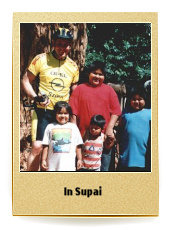 The first thing that struck us was local people's plumpness, to say the least. Perhaps in this area corpulence is a sign of wealth?
The first thing that struck us was local people's plumpness, to say the least. Perhaps in this area corpulence is a sign of wealth?
In a tourist information office we paid a fee for entering the Indian Reservation. After being reprimanded for putting up a tent on a helicopter landing, we were also informed that cycling was not allowed behind that point. Unwillingly, we got off the bikes and walked down the canyon towards the famous waterfalls. What we soon saw was truly amazing. Out of four waterfalls in that area, we saw three. Especially the second (Havasu Falls) and the third one (Mooney Falls) stunned us with their beauty. The size of those natural wonders, matched by the incredible turquoise water, made us forget about the whole world. It was a nice feeling. After all, this is why we did it – to find relief from everyday problems.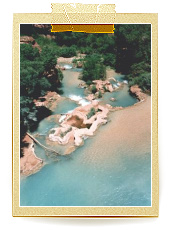
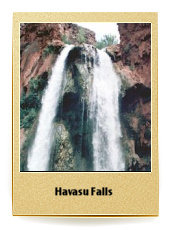 From the bottom of the third waterfall we went down an extremely steep route, holding on to handrails. Thanks to swimming in a turquoise lake and inhaling fresh water vapour, we regained enough energy to go 5 km back to Supai, and then another 13 km to the rim of the canyon.
From the bottom of the third waterfall we went down an extremely steep route, holding on to handrails. Thanks to swimming in a turquoise lake and inhaling fresh water vapour, we regained enough energy to go 5 km back to Supai, and then another 13 km to the rim of the canyon.
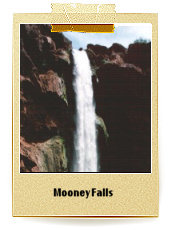
After getting back on the bikes, we did not get too far. Tough luck again: one of Irek's pedals got loose, and the thread broke off. Try as hard as we could, we did not manage to fix it. I wanted to adjust the thread with a knife, but the attempt was futile. Al in all, we had to walk the bike. We reached the top at dusk, completely exhausted. The last section of the route was especially steep and demanding.
We were expecting to find a motel in the vicinity, but there was nothing in sight – not even a tiny shop. We only found a parking area where people were slowly getting ready to sleep in their cars. To make things worse, there were no facilities with running water. We were not prepared for that, contrary to the "inhabitants" of the parking area. They filled our water bottles, and tried to talk us out of cycling down the canyon. "The only way you can go down is on foot, or on horseback – with a guide. It is definitely too steep for a bicycle", they explained. The moment they said it, we knew we would take the risk on bikes, which was a case of typically Polish defiance.
We slept in a tent that night. As we found out in the morning, we put it up on a helicopter landing site - an unintended flight of fancy.

After waking up at 7 am, we quickly took down our tent, packed our backpacks, hopped on the bikes, and off we went. The road downhill was challenging indeed,

 initially very steep, overlooked by canyon walls. Occasionally we had to jump over obstacles, or even get off the bicycles. Further down the canyon the trail became boggy, covered with rubble. Fast cycling was out of the question.
initially very steep, overlooked by canyon walls. Occasionally we had to jump over obstacles, or even get off the bicycles. Further down the canyon the trail became boggy, covered with rubble. Fast cycling was out of the question.
 The tourists we passed on our way stared at us with amazement. We also met the people who had advised us against cycling just a night before. In two hours' time we managed to cover a distance of 13 km, reaching the village of Supai, inhabited by the Havasupai Indians exclusively. The village is situated in a valley, separated from the outside world by vertical canyon walls reaching hundreds of meters up.
The tourists we passed on our way stared at us with amazement. We also met the people who had advised us against cycling just a night before. In two hours' time we managed to cover a distance of 13 km, reaching the village of Supai, inhabited by the Havasupai Indians exclusively. The village is situated in a valley, separated from the outside world by vertical canyon walls reaching hundreds of meters up.
 The first thing that struck us was local people's plumpness, to say the least. Perhaps in this area corpulence is a sign of wealth?
The first thing that struck us was local people's plumpness, to say the least. Perhaps in this area corpulence is a sign of wealth? In a tourist information office we paid a fee for entering the Indian Reservation. After being reprimanded for putting up a tent on a helicopter landing, we were also informed that cycling was not allowed behind that point. Unwillingly, we got off the bikes and walked down the canyon towards the famous waterfalls. What we soon saw was truly amazing. Out of four waterfalls in that area, we saw three. Especially the second (Havasu Falls) and the third one (Mooney Falls) stunned us with their beauty. The size of those natural wonders, matched by the incredible turquoise water, made us forget about the whole world. It was a nice feeling. After all, this is why we did it – to find relief from everyday problems.

 From the bottom of the third waterfall we went down an extremely steep route, holding on to handrails. Thanks to swimming in a turquoise lake and inhaling fresh water vapour, we regained enough energy to go 5 km back to Supai, and then another 13 km to the rim of the canyon.
From the bottom of the third waterfall we went down an extremely steep route, holding on to handrails. Thanks to swimming in a turquoise lake and inhaling fresh water vapour, we regained enough energy to go 5 km back to Supai, and then another 13 km to the rim of the canyon.

After getting back on the bikes, we did not get too far. Tough luck again: one of Irek's pedals got loose, and the thread broke off. Try as hard as we could, we did not manage to fix it. I wanted to adjust the thread with a knife, but the attempt was futile. Al in all, we had to walk the bike. We reached the top at dusk, completely exhausted. The last section of the route was especially steep and demanding.



